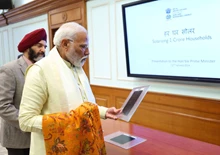
Knowing when the rains will come is very important for farmers as they accordingly plan their next crop. The traditional method of forecasting monsoon has been through the application of statistical tools on historical rain data for broad predictions that is not very correct. Forecast of weather parameters like temperature, humidity & arrival of rainfall can be measured only days before. This is not very helpful as farmers need to plan well in advance.
A scientist at the Belgian Nuclear Research Centre (SCKCEN), Lucrezia Terzi has come up with a new method of predicting the monsoon by calculating how much Beryllium-7, an isotope of the element Beryllium, is there in the air.
Terzi while presenting a paper on the subject at a science & technology convention in Vienna by the Comprehensive Nuclear-Test-Ban Treaty Organisation (CTBTO) said that she tested the method on Indian monsoon in 2018 and was able to forecast it accurately nearly 2 months in advance.
The CTBTO conducted the conference to exhibit how its technologies & system for detecting nuclear explosions can be applied somewhere else - such as monsoon prediction.
It must be noted that CTBTO runs the International Monitoring System of 300-odd stations that can sense vibrations, listen to sounds or smell noble gases (like Xenon, Krypton) ‘radionuclides’ (like Beryllium-7). If a nation sets off a nuclear explosion secretly - whether underground, underwater or in the atmosphere - the International Monitoring System will know all about it within minutes.

Terzi used two of the IMS stations in Dubna, Russia & Melbourne, Australia, to measure the concentration of Beryllium-7 (Be-7), an isotopic variant of the element Beryllium.
She selected Be-7 because it is created only in the stratosphere, when cosmic rays hit and break the nuclei of oxygen and nitrogen. Because of the sun warming the oceans differently at different latitudes and the rotation of the earth, water-bearing air goes up & down in circular fashions and this is the basic reason of the monsoons. When the air flows down from the stratosphere, it carries with it some Be-7. Terzi told that there is a strong link between the amount of Be-7 and the timing of monsoons.
She said that with her technique, one can predict the Indian monsoon 52 days before, with a margin of error of 3 days. The current methods forecast three weeks in advance, with margin of error of 5 days.
Terzi told media that “The beauty of it is that it is very easy”. However she had not yet presented her technique to the Indian authorities.
Martin Kalinowski, an expert who works at the CTBTO said that more work needs to be done before the Be-7 method can be declared scientifically valid.










